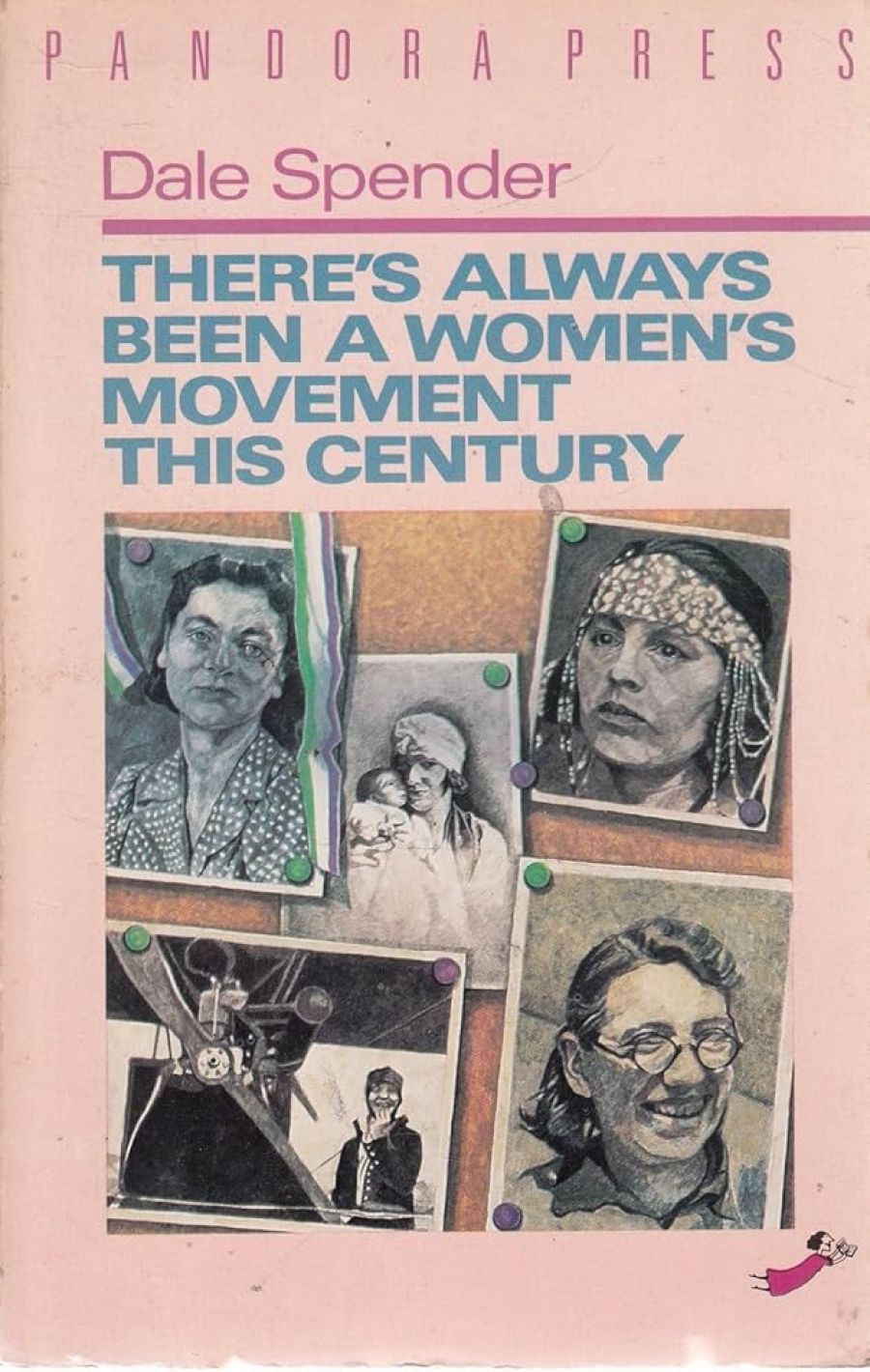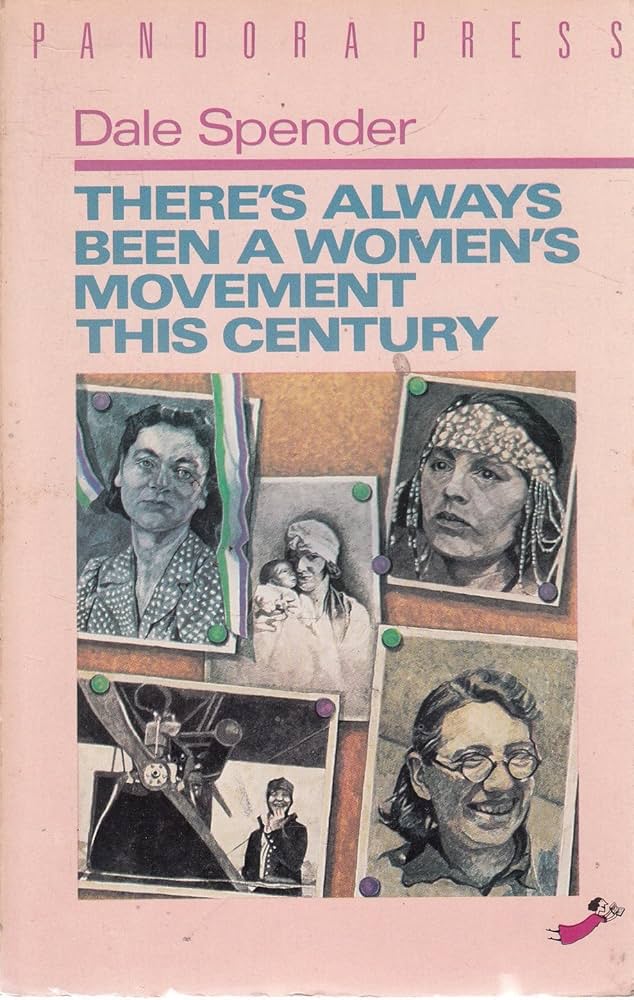
- Free Article: No
- Contents Category: Politics
- Review Article: Yes
- Article Title: Diabolical Conspiracy or Mad Hatter’s Tea Party?
- Online Only: No
- Custom Highlight Text:
‘“No room! No room!” they cried out when they saw Alice coming.’ In her introduction to There's Always Been A Women's Movement this Century, Dale Spender admits that the elan of involvement in the recent women’s movement made her overlook ‘the unlit corridor of women's history’. She deplores ‘the process of reducing women to invisibility’. In a patriarchy, ‘sexism’ is ‘something that all members do ... There weren’t many patriarchal traps that I did not fall into’. Wanting to ‘generate a tradition of strong authoritative women’, she interviewed five ‘elder stateswomen’, all born between 1890 and 1910: journalist and leader of the six Point Group for equality Hazel Hunkins Hallinan; journalist and novelist Rebecca West; pacifist, educationalist and writer Dora Russell; journalist and Fawcett Society stalwart Mary Stott; sociologist Constance Rover. The result was ‘a genuine educational experience’ that prompts some flushed prior publicity: ‘it would be a (patriarchal) mistake to think of these discussions as insignificant but pleasant gossip about old times. This is a form of women's history ... each women tells her own story ... despite all the many limitations, we have here a valuable record’.
- Book 1 Title: Intruders on the Rights of Men
- Book 1 Biblio: Pandora Press, $6.95 pb, 136pp
- Book 2 Title: There's Always Been a Women's Movement this Century
- Book 2 Biblio: Pandora Press, $6.95 pb, 220pp
- Book 2 Cover Small (400 x 600):

- Book 2 Cover (800 x 1200):

The brackets round patriarchal in that statement are electric fences waiting to scorch the presumptuous of either sex; and yet the intensity of Dale’s educational experience lessens the impact of the book for others. Ego and self-involvement may be provinces familar to males but not confined to them. She has a winning theme and rich material, but page after page is dominated by her rhetoric, or comments that are more Dale, veiled in seeming neutrality. She is prone to gratuitous interpolations and extensive digression, such as a blousy defence of consciousness-raising sessions. ‘Outraged’, ‘angered’, beginning ‘to feel [ her] blood boil’, constantly ‘explaining’ and ‘adding’, she sits over the text like a broody hen. Her subjects either fade into nebulosity or become a composite muse cobbled from the author and themselves.
By the last two chapters, she is leading actress, having apparently quelled earlier feelings of being ‘threatened’ by her interviewees. Perhaps Constance Rover is gently suggesting this in the note appended to the chapter on herself: ‘I am both flattered and slightly dismayed at Dale’s account ... Although Dale has kindly shown me her text, to go through it and alter it so that it expressed my precise thought would ... be absurd. It is her book and what comes through very strongly is her deep commitment to the women’s cause, a commitment which I share’.
The book is also marred by its ramblingly informal structure. Although not intended as a collection of potted biographies, the haphazard biographical snippets given are often confusing and tantalising. This is exemplified in her treatment of Dora Russell, placed sentimentally in a white blue-trimmed house at the end of ‘a narrow winding road’. Russell’s autiobiography is ‘readily available’, removing the need for ‘further documentation’. A perhaps justifiable let-out; and yet the chapter is scattered with ragged incident. In 1958 she took a Women’s Caravan of Peace through Europe. In 1923 she visited ‘both Russia and America (and China)’. In 1894 she was born into a middle class family and ‘a secure and happy childhood’. She joined the Heretics in Cambridge.
Bertrand Russell asked her to go to China and in the Red Sea (appropriately?) she discovered that their philosophies diverged. She talked extensively to Jack Reed in Russia just before he died. In China Bertie ‘nearly died and Dora became pregnant, and the two events are not unrelated’ (over-exertion?). She married because Bertie saw the possibility of a male heir. She campaigned for birth control and against the sexual subjection of women. In the twenties she and Bertie started an alternative school (later it emerges that she ran it for 16 years, although Bertie decamped).
There were Cornwall days, ended by divorce, and a last-page catalogue of terse family catastrophes to cover the intervening decades. The lives of all five women are shadowy, an omission given the author’s self-imposed task of rescuing them from the shades.
An atmosphere of paranoiac justification develops. The sheikhs and the eunuchs have been tossed down the wells, while the ladies in the harem share a convivial bowl of Turkish delight. This is winsomely seen when Dale explains to Dora Russel), who has unfashionable views on the biological instincts of women, that lesbianism need not mean childlessness: ‘I launched into a discussion of the magic of Artificial Insemination Devices (even self-help kits) and the marvels of sperm banks’.
There is also the pervasive assumption that ‘male behaviour’ is universally malign and hypocritical. It is impossible to banish an opponent who is merely a bogeyman. Dale refers frequently to the charge of man-hating that is flung at feminists, but there is little evidence of any other emotion towards the bully of the species. When a man capable of ‘an exceptionally egalitarian relationship’ (the husband of Mary Stott) materialises, he rates only a phrase. The truths of these indomitable feminists are undermined by the crudely dichotomous approach of the author. The world is simply US against THEM. There is no real sense of challenge between the author and her subjects who are treated with adulation and described in cliches.
Where there is room for disagreement, a rosy blanket of consensus is dragged out, as if the beleaguered cannot attord nuance and subtlety. What would Dale Spender do with a woman who determinedly disagreed with her?
The best weapon in a struggle is being better than the opposition, more ironical and more withering, wittier and cleverer. Rebecca West, a Sarah Bernhardt of ‘the sex war’, almost makes Dale a willi in the wings. Of the ‘limp sentences’ of Sir Almroth Wright’s Unexpurgated Case Against Woman Suffrage, for instance: ‘They have a brooding look in their eyes like childless women, for every sentence ought to have a little meaning clasped in its arms, but these have none’.
At one point, Dale Spender admits to ‘a grievance ... that so much knowledge women have generated is so depressing’. What must she think of her sister’s cheerless Intruders on the Rights of Men?
Lynne Spender's thesis is grimly straightforward. The males in our society are the ‘gatekeepers’ who determine the dominant values and shape the culture. The printed word, the repository of our heritage, is governed by men. The male- dominated, money-oriented publishing industry is uniquely self-regulating, avoids self-criticism, and builds up a mystique around its allegedly objective judgments. Our society harasses and contains women, undervalues their creative and intellectual achievements and expunges them from the record.
Lynne’s contacts with women writers in four Anglo-Saxon countries suggest that the restrictive practices and attitudes are intact.
Any gains are a temporary quirk, made possible by the current marketability of feminism. Interviews with several publishers’ representatives are similarly dispiriting. Men are the public agents; women fill the private roles (business ineptitude, provides justification). Feminist attitudes are often excised, while self-censorship is rife. Editors’ networks, which include referees and reviewers (often male academics), are crucial, and unsolicited material has small chance of acceptance. Feminist publications, often paperbacks, are categorised as minor or radical, and undercapitalised feminist presses are doomed to marginality (they are rashly presumed to be without restrictive practices).
The present and the future are almost as black as the past. Gains are not only transient; they are ‘manifestations of gatekeeping’. ‘Residual Great Traditionalism’ ensures that few women writers are admitted to the canon. Women were given the vote and education when the powers incorporated there had been substantially eroded. Women are awarded marginally greater recognition when a new technology, again male-dominated, is supplanting publishing as the main communicator.
Much of the book is a hectic compilation of facts and opinions garnered from mostly female secondary sources and repeated as if they are received truth. Its historical sections are sketchy and sometimes a-historical, acting primarily as an adjunct to polemic that often works through repetition rather than elaboration. There is much regurgitation, even to the extent of printing as postscript an article by the author on the main theme that had been commissioned then rejected. Many of the generalisations are sheer over-kill or plainly untrue. Force, rather than originality or style, often makes the baldest claim immediately credible, although a further reading uncovers expressions like ‘clearly’, ‘not surprisingly’ and ‘needless to say’ that clumsily attempt to validate contentious points.
There are no mitigating factors. Any improvement is part of a diabolical conspiracy to perpetuate the patriarchy. Women are kept on stingy rations of recognition and opportunity to ensure that starvation does not erupt in total revolution. Lynne’s world is a paranoid epic in which spiling masks hide brains of devilish thoroughness. Pro-feminist American television programs are tolerated because their message will be neutralised by the intervening advertisements. The effort of rescuing Mary Wollstonecraft’s ideas from oblivion has long postponed their realisation: ‘Cunning, isn’t it?’ In publishing, equal numbers would not ensure power. Feminists are moving into print when paper is dwindling as a resource and literacy levels are dropping, ‘a very effective control over the spread of feminist knowledge’. Even war is perceived as the enemy because it interrupts feminist networks. Then, finally and unanswerably, non-feminist women resist the conspiracy theory.
Of course, as Freud said: the paranoid is not entirely wrong. Stories of condescension, exclusion and cheek are legion. What about an elderly male academic who examined a thesis by a woman knowing that it had been accepted for publication and suggested loftily that the writer pass his dyspeptic detraction over the head of the female commissioning editor to the male chief, presumably to jam the presses? As long as there are gents who think that women are so masochistic, the conspiracy is in worse shape than the Mad Hatter’s tea party.
‘“Well, I’d hardly finished the first verse,” said the Hatter, when the Queen bawled out. “He’s murdering the time! Off with his head!”’


Comments powered by CComment